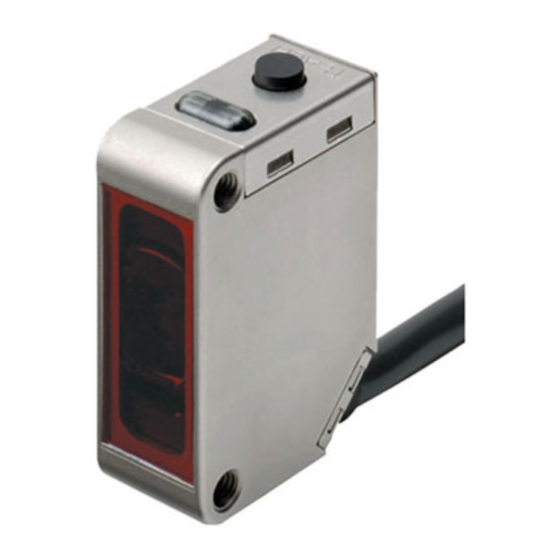Advertisement
Mark Sensor with Stainless Steel Housing
Compact, Photoelectric Sensor with Built-in Amplifier and Teaching Function
E3ZM-V
Color Mark Detection in a World-standard Size (11 × 21 × 32 mm),
with High-speed Response (50 µs) and Accuracy in Spite of
Sensing Object Movement
Another Advance for the E3ZM Series in the Food and Packaging Industries.
Advertisement
Table of Contents

Summarization of Contents
World's Smallest Color-mark Sensor with Built-in Amplifier
Space-saving Design with SUS316L Housing
Compact design reduces volume by 90% and meets world-standard dimensions for installation.
Coaxial Optical System in Compact Design
Uses a coaxial optical system for stable detection even with inclined sensing objects.
IP69K Degree of Protection with SUS316L Housing
SUS316L housing and PES cover offer corrosion resistance and high-pressure water washability.
Color Mark Sensor Technologies
Improved Color-difference Discrimination and RGB Signal Processing
Discriminates fine color differences and offers fast 50 µs response for ON/OFF operations.
Easy Setting with 2-point and Automatic Teaching
Supports manual 2-point teaching and remote automatic teaching for flexible setup.
Ordering Information
Sensor Models and Specifications
Details on sensor models, sensing methods, appearance, connection, distance, and output types.
Sensor I/O Connectors
Details for sensor I/O connectors, including models, cable types, and appearance.
Engineering Data
Color vs. Detection Capability
Details detection capability for various color combinations against different backgrounds.
Detectable Ranges
Graphs showing detectable ranges for different background colors and sensing objects.
Performance Characteristics and Diagrams
Excess Gain vs. Distance
Graph showing the relationship between excess gain and distance.
Angle vs. Incident Characteristics
Graphs illustrating incident light based on the angle of the sensing object.
I/O Circuit Diagrams
Details I/O circuit diagrams, timing charts, and output circuits for NPN and PNP models.
Plugs (Sensor I/O Connectors)
Information on M8 4-pin connectors, including wire color, pin assignment, and application.
Safety Precautions
Nomenclature
Diagram showing indicators and buttons for teaching models.
Precautions for Safe Use
Essential precautions for safe operation, including environment, connectors, and load.
Low-temperature Environments
Caution regarding touching metal surfaces in low-temperature environments.
Oily Environments
Warning against using the Sensor in oily environments due to potential damage.
Modifications
Prohibition of disassembly, repair, or modification of the Sensor.
Outdoor Use
Caution against using the Sensor in locations subject to direct sunlight.
Cleaning Precautions
Precautions on using cleaning agents and high-pressure water to maintain performance.
Surface Temperature
Warning about potential burn injury from the Sensor's surface temperature.
Cable Bending
Caution against bending the cable at temperatures below -25°C to prevent damage.
Precautions for Correct Use
Installation Location Precautions
Avoid locations subject to sunlight, condensation, corrosive gas, vibration, or shock.
Connecting and Mounting
Guidelines for power supply, wiring, cable use, mounting screws, and connector handling.
Power Supply
Information on power supply voltage, grounding, and reset time for stable detection.
Turning OFF the Power Supply
Recommendation to turn off load power supply first to prevent output pulses.
Load Short-circuit Protection
Details on the sensor's short-circuit protection and its reset mechanism.
Water Resistance
Restriction on using the Sensor in water, rainfall, or outdoors.
Resistance to Detergents, Disinfectants, and Chemicals
Table listing substances and their compatibility with the E3ZM sensor.
Restrictions on Sensing Objects
Avoid using the Sensor if background and mark colors/patterns are similar.
Detection of Glossy Objects
Tip to mount the Sensor at an angle (5°-15°) to improve glossy object detection.
Operating Procedure
Two-point Teaching Using Teaching Button
Step-by-step guide for performing 2-point manual teaching of ON and OFF points.
Teaching Success and Failure Indicators
Interpreting stability and teaching indicators for successful or unsuccessful teaching operations.
Automatic Teaching (Remote)
Procedure for Automatic Teaching
Steps for initiating remote automatic teaching via a pulse signal and expected results.
Precautions for Automatic Teaching
Guidelines and considerations for using automatic teaching, including when to use 2-point teaching.
Dimensions
Pre-wired Models (E3ZM-V61, E3ZM-V81)
Dimensional drawings and specifications for pre-wired sensor models.
M8 Connector Models (E3ZM-V66, E3ZM-V86)
Dimensional drawings and terminal assignments for M8 connector sensor models.
E3ZM Series Overview and Specifications
Standard Models (Through-beam, Retro-reflective, Diffuse-reflective)
Specifications for various E3ZM standard models including sensing distance and light source.
BGS Reflective Models
Specifications for BGS reflective models, detailing sensing distance and response time.
PET Bottle Detection Models
Specifications for PET bottle detection models, including sensing distance and power consumption.
Important Information and Disclaimers
Warranty and Limitations of Liability
Details OMRON's warranty terms and limitations of liability for product use.
Suitability for Use
Guidance on product suitability, safety rating, and application considerations.
Performance Data
Information regarding performance data as a guide and not a warranty.
Change in Specifications
Notice on potential changes in product specifications and model numbers.
Errors and Omissions
Statement regarding the accuracy of information and responsibility for errors.
Copyright and Copy Permission
Information on copyright protection and permission for document use.














Need help?
Do you have a question about the E3ZM-V66 and is the answer not in the manual?
Questions and answers